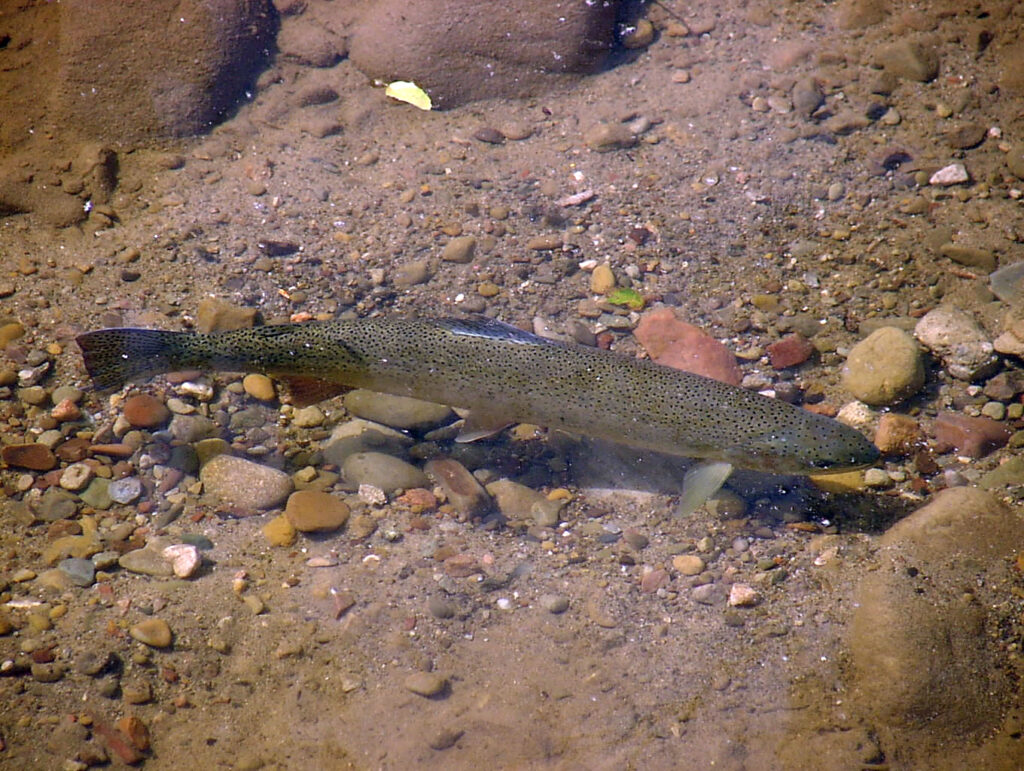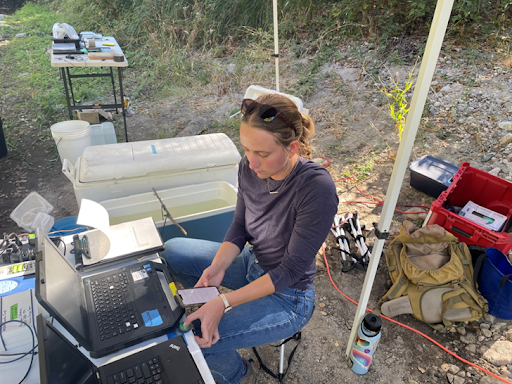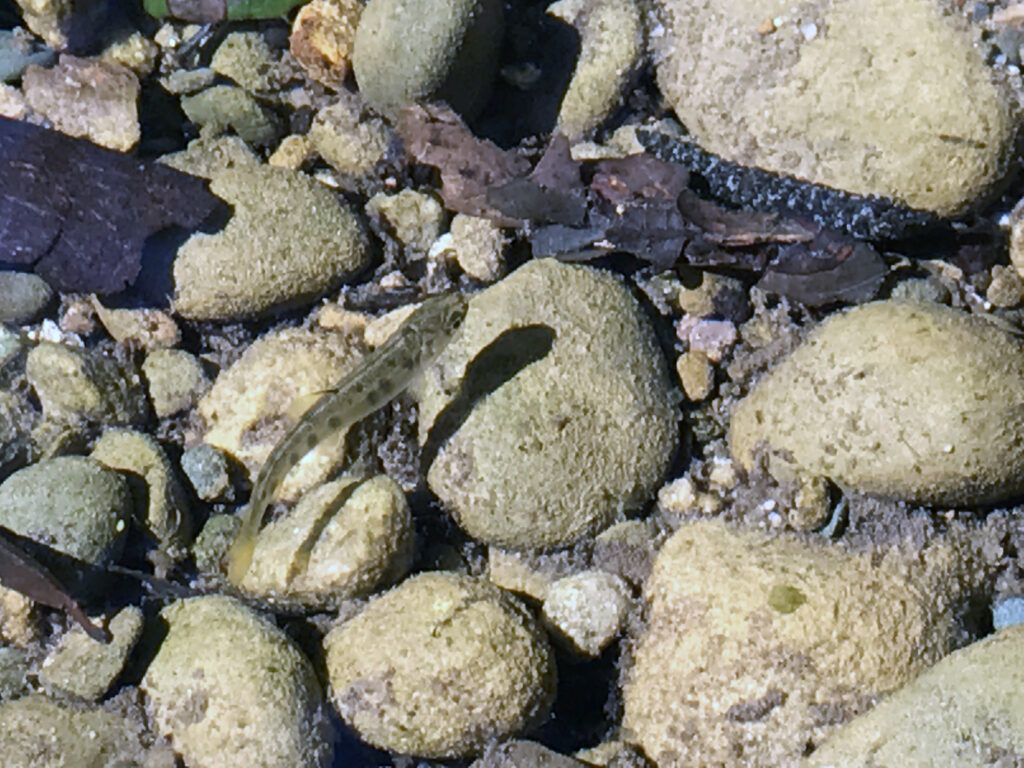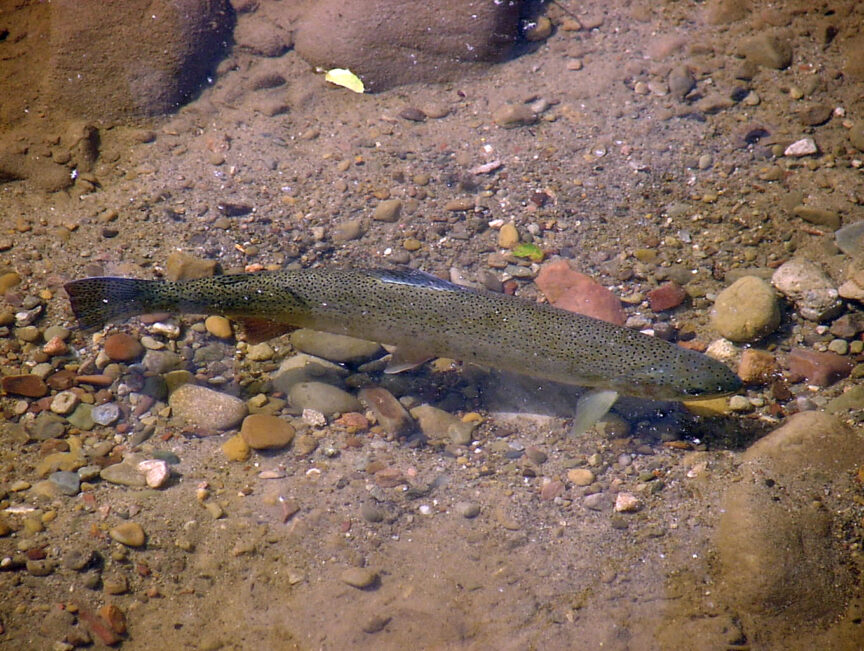
Steelhead in a warming world: insights into thermal tolerance from California steelhead
By Paige Gardner
“So what do you think? Is there any hope for salmon?” a stranger asked me on my flight back to Santa Cruz, California. This stranger went on to tell me that as a kid in Santa Cruz, he remembers seeing innumerable salmon waiting for the San Lorenzo River to breach the sand bar so that they could enter their spawning habitat. Now, following the closure of the recreational and commercial salmon fishery in California due to declining numbers of fish, he travels to Alaska to catch steelhead and king salmon.
This is a common question I get after I tell someone new what my job is—a PhD Student at UC Santa Cruz studying the impacts of climate change on steelhead in coastal California streams. I always answer as honestly as I can: yes, there is hope. But understanding such a grave situation is complex, especially in a state like California.
A Warmer Future
It often feels like salmon are under attack from all sides. California salmon, in the land of near-constant drought, intensive agricultural irrigation, and urbanization, could be foreshadowing what is to come for more northern populations.
Salmon and trout require cold water to survive in all life stages, including egg incubation, rearing, migration, and spawning; however, access to cool, consistent streamflows in much of their current range is declining. In California, dams and other human impacts have cut off salmon from the cold waters they need in upper watersheds (FitzGerald et al., 2021). Not to mention, 2024 was the hottest year on record and 2025 is on track to match it.

Top image: Mark Capelli/NOAA
The growing threat of heat is setting off alarm bells for scientists and agencies across the West Coast. A recent study found that 90% of all steelhead populations are likely to become thermally stressed with climate change (Fitzgerald, 2025). Another study predicted that 78% of all salmonids in California may be extinct due to climate change consequences in the near future (Katz et al., 2013). Rising water temperatures are pushing steelhead and salmon populations to the brink.
Science may help to provide a crucial path forward.
Testing Thermal Tolerance
Across the country, leading institutions are coming together to research the negative impacts of climate change on Pacific salmon and trout. What my collaborators at the UC Santa Cruz Fisheries Collaborative Program and I want to know is: as temperatures increase, can salmon and trout evolve higher thermal tolerance to keep up with the rate of stream warming?
Steelhead are an interesting case study in trying to answer this question. As the most southerly-distributed anadromous salmonid, they have historically persisted as far south as Baja California, Mexico, and as far north as Alaska. While steelhead have been lost from much of their southern range, it is apparent that they have naturally persisted in a wide range of temperatures, hot and cold alike, seemingly less deterred by heat than their salmon relatives.
We hypothesize that populations from historically warm streams may have adaptations that allow them to thrive in higher temperatures compared to populations from historically cold streams, a phenomenon known as local adaptation. Maybe, we hope, steelhead already hold the key to success in a warming world.

To test this hypothesis, we are examining both the physiological and genetic aspects of thermal tolerance in steelhead across a range of streams in California. To try to understand how different stream temperatures have impacted local adaptation of heat tolerance in steelhead populations, my team and I traveled to five different streams in coastal California in the summers of 2024 and 2025. At each site, we collected and tested the upper temperature limits of up to 100 individual fish.
Each fish was placed in a tank of water where we incrementally warmed their environment until the fish was no longer able to stay upright in the water column- essentially, until the fish passed out. The temperature at which a fish loses equilibrium is known as its critical thermal maximum (CTMax), a non-lethal measure that allows us to compare heat tolerance across streams. After each trial, we allowed the fish to recover in cool water before releasing it back to the stream.
While the results from this study are still evolving, early evidence shows that fish from the warmest streams can tolerate significantly higher temperatures than those from cooler sites. The results from this field study are exciting and suggest that populations that have lived in warmer waters for many generations may have evolved a higher capacity for heat.
Additionally, we collected a tissue sample from each fish to sequence its DNA. By analyzing each fish’s genome, we hope to identify the genetic underpinnings of thermal tolerance, both in terms of what specific genes control heat tolerance and how genes are expressed differently in individuals with more or less heat capacity. These gene expression differences are not differences in the DNA itself, but rather how pieces of DNA are turned on or off by environmental factors such as temperature.

Image: Mark Capelli/NOAA
The combination of these two approaches will provide key insights to the ability of steelhead to adapt to rising temperatures, telling us about both inherited and environmentally influenced mechanisms that help steelhead tolerate more or less heat compared to others.
Broader Implications
Steelhead and salmon are faced with the reality of a warming world, but a key takeaway from this study is that not all populations are at the same risk. For example, by understanding the thermal vulnerability of salmon populations, managers can target where and when cold water and habitat conservation is most important to prioritize the most at-risk fish. In addition to habitat restoration, understanding the genetic underpinnings of thermal tolerance can help identify steelhead populations with the adaptive capacity to survive a warming environment. Research from this and similar projects could inform genetic rescue strategies, where managers introduce fish with beneficial genes into a vulnerable population to prevent local extinction. A comprehensive, scientifically-informed approach to conservation is needed to support resilient steelhead populations in a changing climate.
Science provides critical insights to the inner workings of salmon and climate risk. Our goal is to help develop datasets and tools that managers can use to identify our most vulnerable populations and pinpoint our strongest populations that may hold the keys to long-term survival.
An avid angler from Washington state, Paige Gardner is currently a PhD student at UC Santa Cruz and is passionate about conserving salmon, steelhead, and natural resources for future generations.


